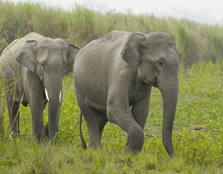

Weekly Current Affairs: Week -4 July 2023 (29 Topics)
Context
“Ludwigia peruviana”, an aquatic weed native to countries like Central and South America, is threatening elephant habitats in Valparai, Tamil Nadu which is further reviving the risk of human-elephant conflicts in the region.
About the species:

- Ludwigia peruviana is an aquatic, sometimes deciduous species of flowering plant in the evening primrose family.
- Ludwigia is among the 22 priority invasive plants in Tamil Nadu.
- It is used as an ornamental plant for its tiny yellow It grows fast along water bodies.
- Ludwigia peruviana, which grows fast along water bodies, has infested the majority of the hill station’s swamps, locally known as vayals, where elephants used to find lush grass even in the summer.
Elephant Habitat in India:
- Currently, they are found in four fragmented populations in the south, north, central and northeast India. Habitat generalists' habitat ranges from wet tropical evergreen forests to semi-arid thorn and scrub forests.
- However, the highest densities of the elephant population are found in tropical deciduous forests.
- According to the report, Karnataka has the highest number of elephants (6,049), followed by Assam (5,719) and Kerala (3,054).
|
Indian Elephant:
|







